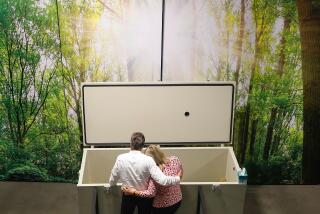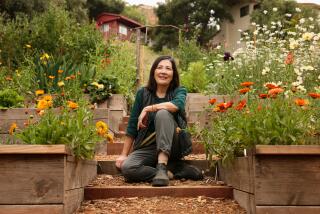That creative spark
“Anything is doable,” Ilse Ackerman declared recently from her Lincoln Heights backyard.
Ackerman was holding a homemade “rammer” -- a huge yogurt cup filled with earth cement and water -- and demonstrating how she built an organic, curved seating area and fire pit with earth bags, dirt-filled polypropylene tube rolls she bought from the California Institute of Earth Art and Architecture in Hesperia.
True to her can-do spirit, Ackerman, whose urban farm Skyfarm was featured in a 2008 Home profile, built the outdoor lounge herself over three months using books, the Internet, YouTube and her own thriftiness. (For step-by-step photographs by husband Meeno Peluce, go to www.la times.com/home).
The idea formed when Ackerman spent an evening curled up next to a friend’s fire pit. “I thought to myself, ‘I want one,’” she said.
But she also wanted something organic -- an outdoor lounge modeled on homes she had seen in Morocco built with straw and manure.
When an apricot tree in her backyard died, she took it as a sign to get started.
A friend suggested earth bags -- a low-cost sustainable way of building with rammed earth -- but Ackerman joked that it sounded “too hippie even for me.”
She changed her mind. Partly inspired by Mark Frauenfelder’s book “Made by Hand: Searching for Meaning in a Throwaway World,” Ackerman decided to teach herself how to build with earth bags, and as cheaply as possible.
She began by digging up the tree roots, excavating the area and piping the gas to the firepot. “I was so cheap I did not even buy the earth bag book,” she laughed. “I checked ‘Earthbag Building’ by Kaki Hunter out of the library.” Ackerman figured out how to pipe the gas by watching a YouTube video.
Working while her two daughters were in school, Ackerman filled the polypropylene bags with dirt from the excavated area via a tube and tamped the ends. Because she was working alone, the project went slowly.
In between each layer, she placed barbed wire, to keep the layers from shifting. When she was finished stacking the dirt-filled bags, she covered everything in chicken wire. A rough coat of concrete Spec Mix came next, followed by a super smooth coat.
When it came to color, Ackerman was unhappy with the terra cotta pigment she first applied. “It wasn’t enough of a statement,” she said. So she began researching lime wash, which she had heard was weather- and rot-resistant. “Over time it develops a much more beautiful aged finish,” she said. The only problem? “It is almost impossible to find lime wash,” she sighed. She finally found Australian lime wash at Jill’s Paint in Atwater Village. The clerk’s advice: “Go darker,” prompting her to choose a deep Indian pink.
Ackerman now acknowledges that she was not completely sold on the earth bags until she started applying the smooth coat. “It was then that I started feeling like it was going to be OK,” she said. “I was looking at it and thinking, ‘This looks terrible,’” she said. “It looked like weird white tubes until I tacked down the chicken wire.”
The playful environment is a hit with her family and even inspired Ackerman to install a new flagstone and cement patio. True to her do-it-yourself project, she rented a jackhammer and took up the original patio herself.
“It was not as hard as I thought,” she said.
Today, Ackerman is pleased with the results of her hard labor, which she estimates cost under $1,000. She is also honest about tackling another such project alone: “I could never do it again,” she said.
“It’s been a nice addition to our yard,” she said. “The girls love it. They wanted a dedicated couch area. And it’s great to be in the hot tub and sit next to the fire.”
And what’s next for the always-changing Skyfarm?
“I’m really interested in geese and goats ...” she said before taking off to collect some fruit trees for a school orchard.
--







